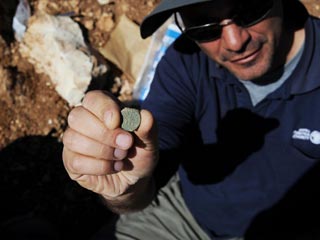
PREV ARTICLE
NEXT ARTICLE
FULL ISSUE
PREV FULL ISSUE
GREAT REVOLT COIN HOARD UNCOVERED IN JERUSALEM
This article from Israel describes a coin hoard uncovered while widening a highway.
-Editor
In one of the houses, archaeologists found a ceramic box containing 114 bronze coins dating to the fourth year of the Great Revolt by the Jews against the Romans before the destruction in 70 AD of the Temple built by King Herod. Israel Antiquities Authority excavation directors Pablo Betzer and Eyal Marco said the coins appear to have been buried several months prior to the fall of Jerusalem at the end of the rebellion. "Evidently someone here feared the end was approaching and hid his property, perhaps in the hope of collecting it later when calm was restored to the region," one of the directors explained. One side of the coins is stamped with a chalice and the Hebrew inscription "To the Redemption of Zion." The motif on the other side, inscribed "Year Four," meaning the fourth year of the Great Revolt, includes a bundle of lulav and two etrogs, used during Sukkot, the Feast of Tabernacles. The directors found the coin cache in a corner of three-room building with a courtyard. It could have been buried inside a wall or in the floor, they said.
To read the complete article, see:
2,000-Year-Old Coin Cache Uncovered
(www.cbn.com/cbnnews/insideisrael/2014/August/2000-Year-Old-Coin-Cache-Uncovered-/)
The Numismatic Bibliomania Society is a non-profit organization promoting numismatic literature. See our web site at coinbooks.org. To submit items for publication in The E-Sylum, write to the Editor at this address: whomren@gmail.com To subscribe go to: https://my.binhost.com/lists/listinfo/esylum All Rights Reserved. NBS Home Page Contact the NBS webmaster 
|
